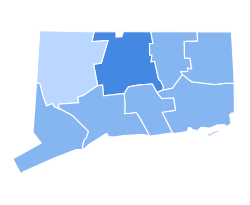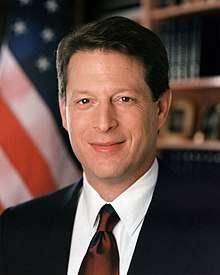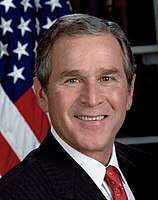2000 United States presidential election in Connecticut
The 2000 United States presidential election in Connecticut took place on November 7, 2000, and was part of the 2000 United States presidential election. Voters chose 8 representatives, or electors to the Electoral College, who voted for president and vice president.
| ||||||||||||||||||||||||||
| ||||||||||||||||||||||||||
 County Results
Gore 40-50% 50-60% 60-70%
| ||||||||||||||||||||||||||
| ||||||||||||||||||||||||||
| Elections in Connecticut | ||||||||||
|---|---|---|---|---|---|---|---|---|---|---|
 | ||||||||||
|
||||||||||
|
||||||||||
Connecticut was won by Vice President Al Gore by a 17.5% margin of victory. Gore's vice presidential running mate, Joe Lieberman, had been a U.S. Senator from Connecticut since 1989. Connecticut had also been the birth state of Republican nominee George W. Bush, however as a presidential candidate Bush identified his home state as Texas, where he was governor, and he did not attempt to compete in Connecticut. Connecticut is considered a safe Democratic state, having not been won by a Republican presidential candidate since Bush's father George H. W. Bush in 1988. Connecticut is also the birth state of major Green Party candidate Ralph Nader.
Results
| 2000 United States presidential election in Connecticut | |||||
|---|---|---|---|---|---|
| Party | Candidate | Votes | Percentage | Electoral votes | |
| Democratic | Al Gore | 816,015 | 55.91% | 8 | |
| Republican | George W. Bush | 561,094 | 38.44% | 0 | |
| Green | Ralph Nader | 64,452 | 4.42% | 0 | |
| Concerned Citizens | Howard Phillips | 9,695 | 0.66% | 0 | |
| Reform | Patrick Buchanan | 4,731 | 0.32% | 0 | |
| Libertarian | Harry Browne | 3,484 | 0.24% | 0 | |
| Natural Law | John Hagelin | 40 | 0.00% | 0 | |
| Independent | Write Ins | 14 | 0.00% | 0 | |
| Totals | 1,459,527 | 100.00% | 8 | ||
| Voter turnout (Voting age) | 57% | ||||
Results breakdown
By county
| County[1] | Gore% | Gore# | Bush% | Bush# | Others% | Others# |
|---|---|---|---|---|---|---|
| Fairfield | 52.3% | 193,769 | 43.1% | 159,659 | 4.6% | 16,861 |
| Hartford | 60.2% | 221,167 | 34.7% | 127,468 | 5.1% | 18,921 |
| Litchfield | 47.9% | 41,806 | 44.9% | 39,172 | 7.2% | 6,360 |
| Middlesex | 55.9% | 43,319 | 37.8% | 29,295 | 6.3% | 4,819 |
| New Haven | 58.0% | 197,928 | 36.0% | 122,919 | 6.0% | 20,252 |
| New London | 55.9% | 60,449 | 37.7% | 41,168 | 6.4% | 7,530 |
| Tolland | 53.5% | 33,554 | 39.4% | 24,705 | 7.1% | 4,441 |
| Windham | 54.6% | 24,023 | 38.0% | 16,708 | 7.4% | 3,232 |
By congressional district
Gore won all 6 congressional districts.
| District | Bush | Gore | Representative |
|---|---|---|---|
| 1st | 32% | 62% | John Larson |
| 2nd | 38% | 56% | Sam Gejdenson |
| Rob Simmons | |||
| 3rd | 34% | 60% | Rosa DeLauro |
| 4th | 41% | 55% | Christopher Shays |
| 5th | 44% | 51% | James H. Maloney |
| 6th | 42% | 52% | Nancy Johnson |
Electors
Technically the voters of Connecticut cast their ballots for electors: representatives to the Electoral College. Connecticut is allocated 8 electors because it has 6 congressional districts and 2 senators. All candidates who appear on the ballot or qualify to receive write-in votes must submit a list of 8 electors, who pledge to vote for their candidate and his or her running mate. Whoever wins the majority of votes in the state is awarded all 8 electoral votes. Their chosen electors then vote for president and vice president. Although electors are pledged to their candidate and running mate, they are not obligated to vote for them. An elector who votes for someone other than his or her candidate is known as a faithless elector.
The electors of each state and the District of Columbia met on December 18, 2000[2] to cast their votes for president and vice president. The Electoral College itself never meets as one body. Instead the electors from each state and the District of Columbia met in their respective capitols.
The following were the members of the Electoral College from the state. All were pledged to and voted for Gore and Lieberman:[3]
- Nick Balletto
- Frank Cirillo
- Marilyn Cohen
- Gloria Collins
- Kimberly Ford
- Thomas McDonough
- Ken Slapin
- Clorinda Soldevila
References
- http://uselectionatlas.org/RESULTS/
- http://www.uselectionatlas.org/INFORMATION/ARTICLES/pe2000timeline.php
- "Archived copy". Archived from the original on 2012-02-12. Retrieved 2009-10-25.CS1 maint: archived copy as title (link)


